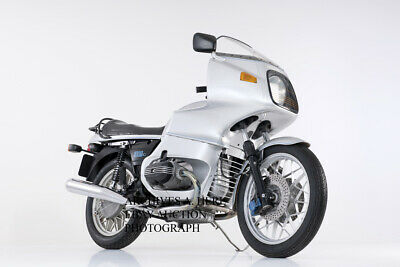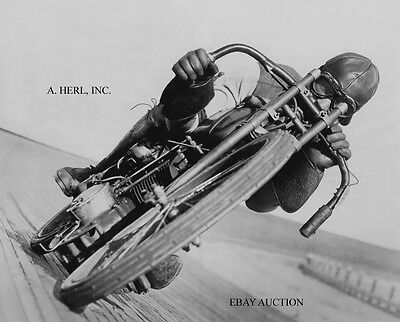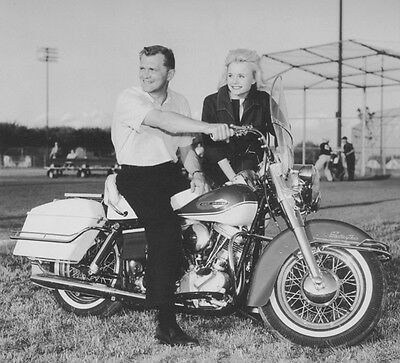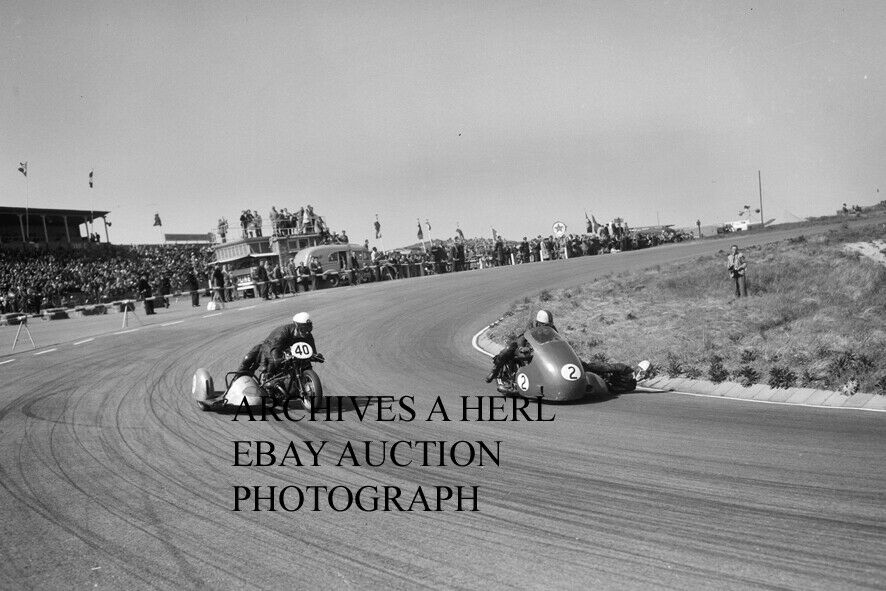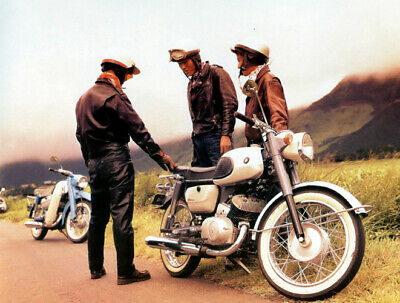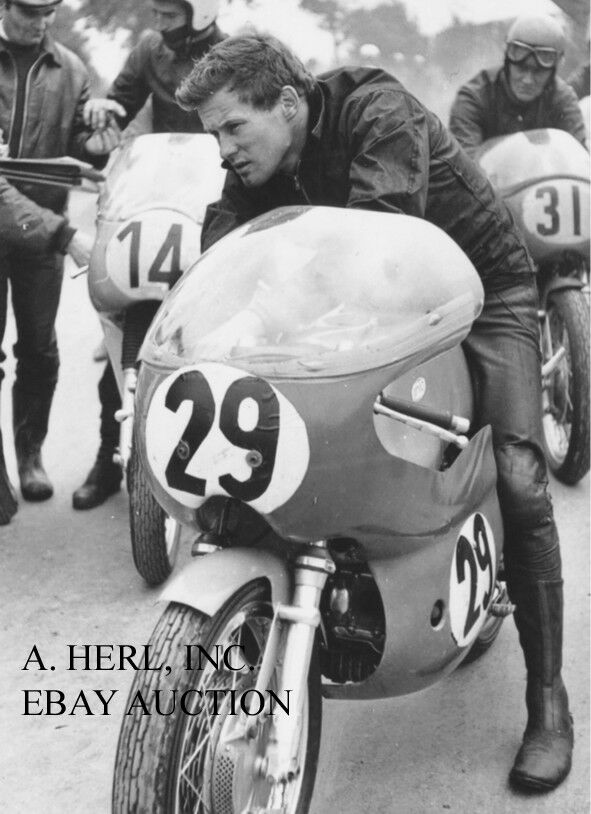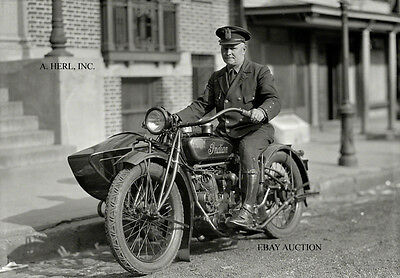-40%
Harley Davidson 61ci EL Knucklehead 1938 motorcycle photo photograph
$ 5.14
- Description
- Size Guide
Description
A superb and rare photo of the powerful1938 Harley-Davidson 61 c.i. EL Knucklehead
Big Twin model.
In 1936 H-D introduced the 61 c.i. (1,000cc) OHV Knucklehead model series. Its massive V-twin overhead valve HD engine performed remarkably well.
Together with the new Knucklehead a new, more modern styling was introduced on the big
Harley
models. The
Harley-Davidson
Knucklehead
engine was named after the distinct shape of the rocker boxes. The V-twin engine featured two valves per cylinder which were operated by pushrods. It was the third type of V-Twin engine used by Harley-Davidson, replacing the Flathead engine in 1936 (which had replaced the F-head or IOE engine on big twins in 1930). The engine was manufactured until 1947 and was replaced by the Panhead engine in 1948. As the design of Harley-Davidson engines has evolved through the years, the distinctive shape of the valve covers has allowed
Harley
enthusiasts to classify an engine simply by looking at the shape of the cover. A knucklehead engine has round knobs on the cover resembling knuckles that give the knucklehead its name.
Harley-Davidson
has a long and very interesting history that started as early as in 1901. That year,
William
S.
Harley
, age 21, drew up plans for a small engine with a displacement of 7.07 cubic inches (116 cc) and four-inch (
102 mm
) flywheels. The engine was designed for use in a regular pedal-bicycle frame. Over the next two years
Harley
and his childhood friend
Arthur
Davidson
labored on their motor-bicycle using the northside
Milwaukee
machine shop at the home of their friend,
Henry
Melk
. It was finished in 1903 with the help of
Arthur
's brother,
Walter
Davidson
. Upon completion the boys found their power-cycle unable to conquer
Milwaukee
's modest hills without pedal assistance. Will
Harley
and the
Davidsons
quickly wrote off their first motor-bicycle as a valuable learning experiment. Work immediately began on a new and improved second-generation machine. This first "real" Harley-Davidson motorcycle had a bigger engine of 24.74 cubic inches (405 cc) with 9.75 inches (
25 cm
) flywheels weighing
28 lb
(
13 kg
). The machine's advanced loop-frame pattern was similar to the 1903 Milwaukee Merkel motorcycle (designed by
Joseph
Merkel
, later of Flying Merkel fame). The bigger engine and loop-frame design took it out of the motorized-bicycle category and would help define what a modern motorcycle should contain in the years to come. The boys also received help with their bigger engine from outboard motor pioneer Ole Evinrude, who was then building gas engines of his own design for automotive use on
Milwaukee
's
Lake Street
. The prototype of the new loop-frame Harley-Davidson was assembled in a 10 ft × 15 ft (3.0 m × 4.6 m) shed in the
Davidson
family backyard. Most of the major parts, however, were made elsewhere, including some probably fabricated at the
West Milwaukee
railshops where oldest brother
William
A.
Davidson
was then toolroom foreman. This prototype machine was functional by September 8, 1904, when it competed in a
Milwaukee
motorcycle race held at
State
Fair
Park
. It was ridden by
Edward
Hildebrand
and placed fourth. This is the first documented appearance of a Harley-Davidson motorcycle in the historical record. In January 1905, small advertisements were placed in the "Automobile and Cycle Trade Journal" that offered bare Harley-Davidson engines to the do-it-yourself trade. By
April
, complete motorcycles were in production on a very limited basis. That year the first Harley-Davidson dealer,
Carl
H.
Lang
of
Chicago
, sold three bikes from the dozen or so built in the
Davidson
backyard shed. (Some years later the original shed was taken to the
Juneau Avenue
factory where it would stand for many decades as a tribute to the Motor Company's humble origins. Unfortunately, the first shed was accidentally destroyed by contractors in the early 1970s during a clean-up of the factory yard.) In 1906,
Harley
and the
Davidsons
built their first factory on
Chestnut Street
(later
Juneau Avenue
). This location remains the Motor Company's corporate headquarters today. The first
Juneau Avenue
plant was a 40 by 60-foot (
18 m
) single-story wooden structure. That year around 50 motorcycles were produced. In 1907,
William
S.
Harley
graduated from the University of Wisconsin–Madison with a degree in mechanical engineering. That year additional factory expansion came with a second floor and later with facings and additions of
Milwaukee
pale yellow ("cream") brick. With the new facilities production increased to 150 motorcycles in 1907. The company was officially incorporated that September. They also began selling their motorcycles to police departments around this time, a market that has been important to them ever since. Production in 1905 and 1906 were all single-cylinder models with 26.84 cubic inches (439.8 cc) engines. In February
1907 a
prototype model with a 45-degree V-Twin engine was displayed at the Chicago Automobile Show. Although shown and advertised, very few V-Twin models were built between 1907 and 1910. These first V-Twins displaced 53.68 cubic inches (879.7 cc) and produced about 7 horsepower (5.2 kW). This gave about double the power of the first singles. Top speed was about
60 mph
(
97 km/h
). Production jumped from 450 motorcycles in 1908 to 1,149 machines in 1909. By 1911, some 150 makes of motorcycles had already been built in the
United States
– although just a handful would survive the 1910s. In 1911, an improved V-Twin model was introduced. The new engine had mechanically operated intake valves, as opposed to the "automatic" intake valves used on earlier V-Twins that opened by engine vacuum. With a displacement of 49.48 cubic inches (810.8 cc), the 1911 V-Twin was smaller than earlier twins, but gave better performance. After 1913 the majority of bikes produced by Harley-Davidson would be V-Twin models. By 1913, the yellow brick factory had been demolished and on the site a new 5-story structure of reinforced concrete and red brick had been built. Begun in 1910, the red brick factory with its many additions would take up two blocks along
Juneau Avenue
and around the corner on
38th Street
. Despite the competition, Harley-Davidson was already pulling ahead of Indian and would dominate motorcycle racing after 1914. Production that year swelled to 16,284 machines. In 1917, the
United States
entered World War I and the military demanded motorcycles for the war effort.
Harleys
had already been used by the military in the Pancho Villa Expedition but World War I was the first time the motorcycle had been adopted for combat service. Harley-Davidson provided about 15,000 machines to the military forces during World War I. By 1920, Harley-Davidson was not by far the largest motorcycle manufacturer in the world, though their motorcycles were sold by dealers in 67 countries. Production was 28,189 machines. In
1921, a
Harley-Davidson, ridden by Otto Walker, was the first motorcycle ever in the
USA
to win a race at an average speed of over
100 mph
(
160 km/h
). During the 1920s, several improvements were put in place, such as a new 74 cubic inch (1200cc) V-Twin, introduced in 1922, and the "Teardrop" gas tank in
1925. A
front brake was added in
1928. In
the late summer of 1929, Harley-Davidson introduced its 45 cubic inch flathead V-Twin to compete with the Indian 101 Scout and the Excelsior Super X. This as the "D" model, produced from 1929 to 1931. Riders of Indian motorcycles derisively referred to this model as the "three cylinder
Harley
" because the generator was upright and parallel to the front cylinder. The 2.745 in (69.7 mm) bore and 3.8125 in (96.8 mm) stroke would continue in most versions of the 750 engine; exceptions include the XA and the XR750. The Great Depression began a few months after the introduction of their 45 cubic inch model. Harley-Davidson's sales plummeted from
21,000 in
1929 to
3,703 in
1933. Despite those dismal numbers, Harley-Davidson proudly unveiled its lineup for 1934, which included a Flathead with art deco styling. In order to survive the remainder of the Depression, the company manufactured industrial powerplants based on their motorcycle engines. They also designed and built a three-wheeled delivery vehicle called the Servi-Car, which remained in production until
1973. In
the mid-'30s,
Alfred
Rich
Child
opened a production line in
Japan
with the 74ci VL. The Japanese license-holder severed its business relations with Harley-Davidson in 1936 and continued manufacturing the VL under the Rikuo name. An 80 cubic inch flathead engine was added to the line in 1935, by which time the single-cylinder motorcycles had been discontinued. In 1936, the 61E and 61EL models with the "Knucklehead" OHV engines was introduced. Valvetrain problems in early Knucklehead engines required a redesign halfway through its first year of production and retrofitting of the new valvetrain on earlier engines. By 1937, all Harley-Davidson's flathead engines were equipped with dry-sump oil recirculation systems similar to the one introduced in the "Knucklehead" OHV engine. The revised 74 cubic inch V and VL models were renamed U and UL, the 80 cubic inch VH and VLH to be renamed UH and ULH, and the 45 cubic inch R to be renamed W.
In 1941, the 74 cubic inch "Knucklehead" was introduced as the F and the FL. The 80 cubic inch flathead UH and ULH models were discontinued after 1941, while the 74" U & UL flathead models were produced up to 1948. One of only two American cycle manufacturers to survive the Great Depression, Harley-Davidson again produced large numbers of motorcycles for the US Army in World War II and resumed civilian production afterwards, producing a range of large V-twin motorcycles that were successful both on racetracks and for private buyers. Harley-Davidson, on the eve of World War II, was already supplying the Army with a military-specific version of its 45" WL line, called the WLA. (The A in this case stood for "Army".) Upon the outbreak of war, the company, along with most other manufacturing enterprises, shifted to war work. Over 90,000 military motorcycles, mostly WLAs and WLCs (the Canadian version) would be produced, many to be provided to allies. Harley-Davidson received two Army-Navy ‘E’ Awards, one in 1943 and the other in 1945, which were awarded for Excellence in Production. Shipments to the
Soviet Union
under the Lend-Lease program numbered at least 30,000. The WLAs produced during all four years of war production generally have 1942 serial numbers. Production of the WLA stopped at the end of World War II, but was resumed from 1950 to 1952 for use in the Korean War. The U.S. Army also asked Harley-Davidson to produce a new motorcycle with many of the features of BMW's side-valve and shaft-driven R71.
Harley
largely copied the BMW engine and drive train and produced the shaft-driven 750 cc 1942
Harley
-
Davidson
XA
. This shared no dimensions, no parts and no design concepts (except side valves) with any prior Harley-Davidson engine. Due to the superior cooling of the flat-twin engine with the cylinders across the frame, Harley's XA cylinder heads ran
100 °F
(
56 °C
) cooler than its V-twins. The XA never entered full production: the motorcycle by that time had been eclipsed by the Jeep as the Army's general-purpose vehicle, and the WLA—already in production—was sufficient for its limited police, escort, and courier roles. Only 1,000 were made and the XA never went into full production. It remains the only shaft-driven Harley-Davidson ever made. As part of war reparations, Harley-Davidson acquired the design of a small German motorcycle, the DKW RT125 which they adapted, manufactured, and sold from 1947 to 1966
We have more photos, also listed on Ebay, of other bikes, and various motorcycle (world) champions on various kinds of machinery. Please check out our auctions and take advantage of our shipping discount! The auction selection is refreshed and changed continuously.
This is your rare chance to own this
non period
photo that reflects a very interesting and historic piece of motorcycle history. Therefore it is printed in a nice large format of ca. 8" x
12”
(ca. 20 x
30 cm
).
Shipping costs will only be $ 7.00 regardless of how many photos you buy. For 5 or more photos, shipping is free!
(Note: A. Herl, Inc. does not appear on photo, for ebay purposes only)
No copyright expressed or implied. Sold as collectable item only. We are clearing out our archives that we have gathered from various sources.
All items always sent well protected in PVC clear files
and board backed envelopes.
We have photographs that came from professional collections and/or were bought from the original photographer or press studio! They are all of professional and excellent quality.
After many decades of professionally collecting photographs and posters we are clearing out our archives. They make the perfect gift and are perfectly suited for framing. They will look gorgeous unframed and will be a true asset nicely framed with a border. They are a gorgeous and great asset in every home, workshop, workplace, restaurant, bar or club!
First come - first served. And you can always contact us for your requests. Please ask any questions before the auction ends.

